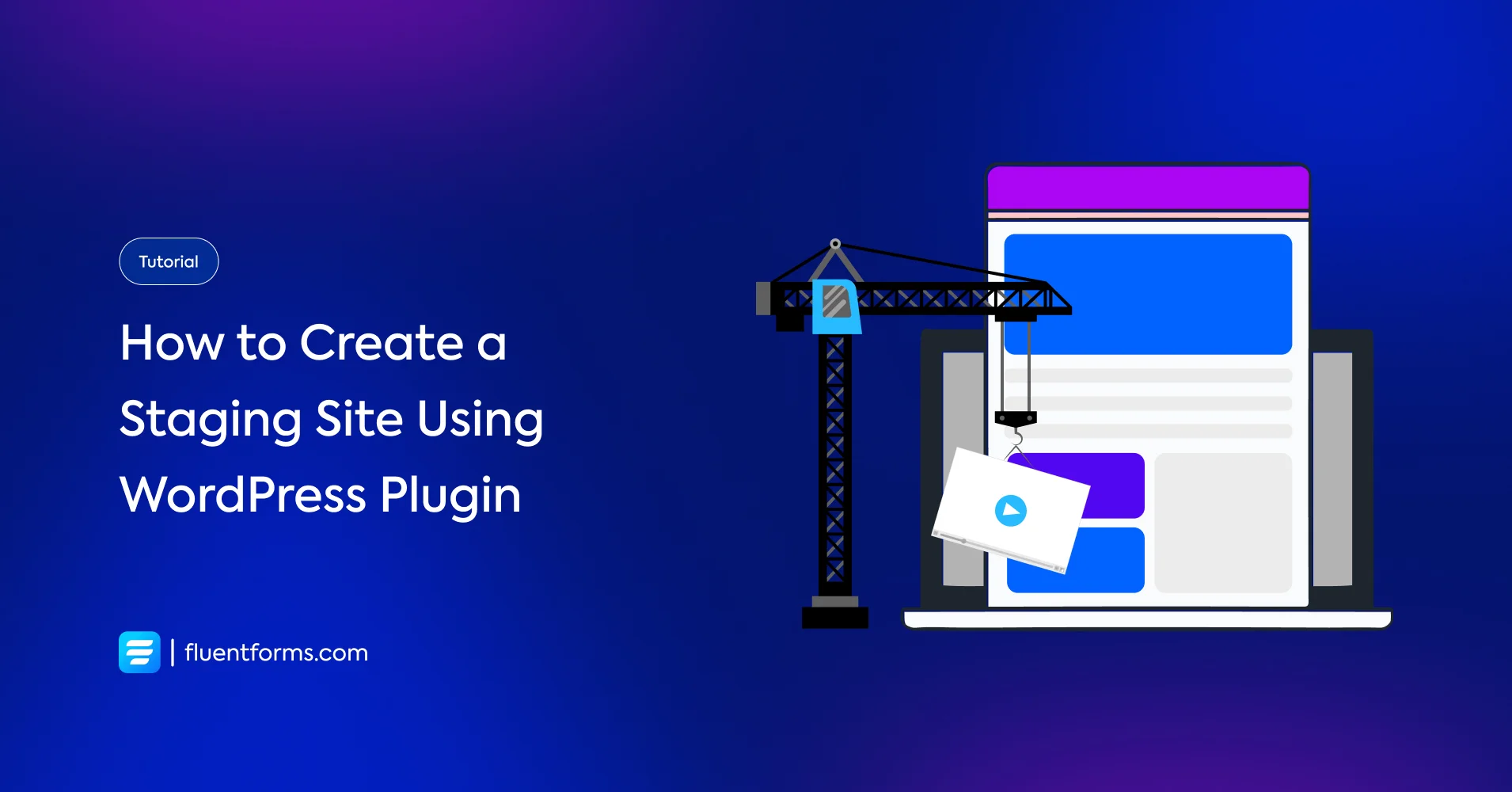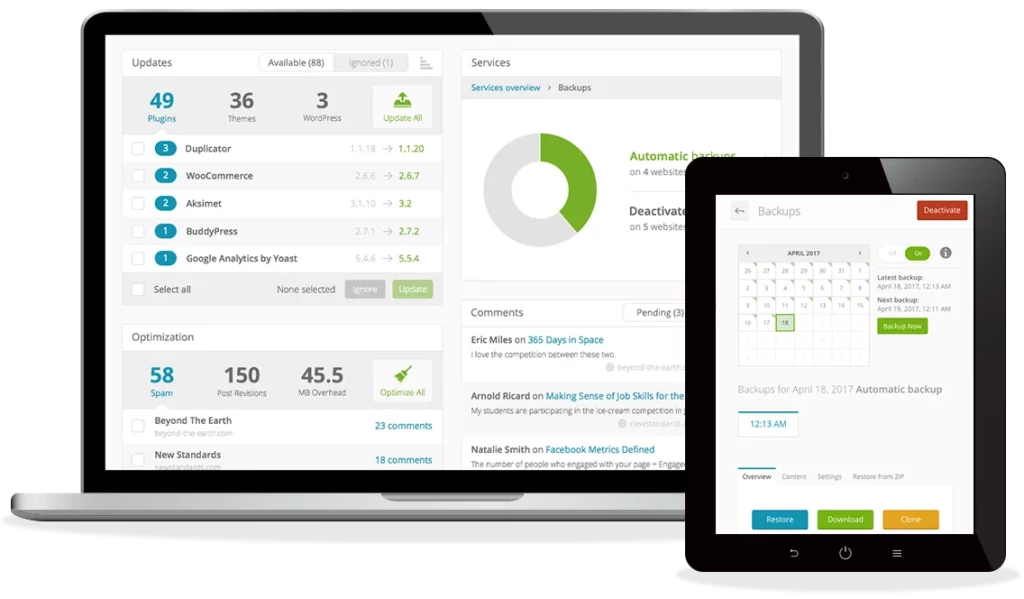Creating a Staging Site Using WordPress Staging Plugins

WordPress staging plugins are one of the popular ways to create a WordPress staging site, backup, or migration. The staging site is a must-have thing if your website is running your business.
Choosing WordPress staging plugins might be a struggle as there are many options in the market. That’s why this blog will help you decide on your staging plugins and also cover how to use them for creating a WordPress staging site.
Let’s dive in!
What is a staging site or staging environment
A staging site is like an exact copy of your real site. The fun part is that you can do whatever you want on a staging site, which won’t affect the real one.
Creating a staging environment helps you experiment with your site without risking anything.
Simply put, it’s like entering a stage before the play, rehearsing your lines, and tweaking anything you want without fearing getting judged. Whatever you do on a staging site isn’t shown to the website visitors.
Benefits and challenges of a staging site
Creating a staging site comes with both benefits and challenges.
Now, about the benefits:
- You can update WordPress safely
- Creating staging websites is easy
- You have complete freedom to test your changes
Regarding the challenges:
- Usually, the staging feature isn’t free
- Longer website updating time
How to create a staging site on WordPress
There are several ways to create a WordPress staging site. We can categorize them according to their difficulties.
Beginner-friendly ways to create a WordPress staging site:
- Create one through your web host
- Using WordPress staging plugins
A slightly advanced way to create a WordPress staging site:
- Create staging site manually
In this blog, we’ll only cover the process of creating a staging site on WordPress using the WordPress staging plugins.
Selecting the best WordPress staging plugin for your needs
Picture this: You’re about to update your WordPress site, but you’re nervous. What if something goes wrong? What if your site crashes, and your visitors see a mess? That’s where staging plugins swoop in to save the day.
A staging plugin lets you create a clone of your site- a safe space to test updates, try new plugins, or tweak your design. No risk, no stress.
But with so many options out there, how do you pick the right one? It’s not as tricky as it sounds. Focus on these must-have features, including new features that make your life easier, like:
- One-click staging: Because who has time for complicated setups?
- Easy deployment: When your tests are a success, pushing changes to live should be a breeze.
- Compatibility: Make sure it plays nicely with your hosting provider.
- Regular updates: A plugin that’s kept fresh is less likely to cause headaches.
- Solid support: If you hit a snag, help should be just a click away.
Some staging plugins are free, while others come with a price tag. Free plugins might have limited features, so consider your needs and budget. Sometimes, investing in a premium plugin can save you time and hassle in the long run.
To narrow it down, check out user reviews and ratings on WordPress.org. See what others are saying, and look for any red flags.
Also, glance at the “Last Updated” date. If it’s been ages, that plugin might not be compatible with the latest WordPress version, and that’s a recipe for trouble.
Choose wisely, and you’ll have a trusty sidekick for all your WordPress adventures. Your live site will thank you, and so will your visitors.
Now let’s line up some popular WordPress staging plugins and check out how to use them for creating a WordPress staging site.
1. WP Staging
WP Staging provides one of the easiest ways to create a staging site in just a few clicks. It creates a clone of your website into a subfolder. In the background, the files and database are copied and the links within the content are also replaced with the new path.
The free plugin has 100,000+ active installations and 4.8-star ratings. The Pro edition supports WordPress multisite, cloning for subdomains, and the ability to copy modifications from the staging site to the live website.
Steps to use WP Staging:
1. Install the WP Staging plugin on the main site
2. Name your staging site (a subfolder) and start cloning using WP Staging
3. Login to your new staging site
2. Duplicator
Duplicator is another popular WordPress migration plugin like All-in-One WP Migration. It creates a package file and installer for easy website restoration on a blank site. Need not have existing WordPress installation on the target site.
This free plugin has over 1 million active installations and 4.9-star ratings. Its Pro version supports scheduled backups, cloud storage, multisite, cPanel integration, and more.
Steps to use Duplicator:
1. Install Duplicator plugin
2. Create a new package using Duplicator
3. Download the installer and package file
4. Upload installer and package file to target site (subfolder, subdomain, or domain)
5. Run the Duplicator installer to restore the website
6. You’re all set
3. All-in-One WP Migration
All-in-One WP Migration is one of the most popular plugins for migrating a WordPress site from one host to another. Its ability to package the entire site-both files and database into a single file for easy migration also makes it an ideal tool for creating a staging site.
The free plugin has over 5 million active installations and 4.5-star ratings (6000+ 5 Stars). The plugin’s premium extensions support unlimited website size, cloud storage, multisite, and more.
You’ll first need to set up a fresh WordPress installation on the staging environment to use the All-in-One WP Migration plugin for your staging site. This is a prerequisite before you can import the website package file. You have flexibility in where you set up the staging site- it can be:
- A subfolder
- A subdomain
- A different domain
Once WordPress is installed on the staging site, you can proceed with importing the All-in-One WP Migration package file. However, note that the maximum size for the website export package is 512MB. Ensure your site’s data, including files and database, fits within this limit to avoid issues during the migration.
Steps to use All-in-One WP Migration:
1. Install WordPress on the staging site
2. Install the All-in-One WP Migration plugin on both main and staging sites
3. Export the main site using All-in-One WP Migration with staging site URL replacement
4. Import the website package file on the staging site
5. Now it’s all set
4. WP Stagecoach
WP Stagecoach is a premium one-click WordPress staging site solution that works on any host and does not overwrite the database during import.
Database merging is a unique feature that allows you to push staging site changes to the live site without replacing the live site’s database. WP Stagecoach monitors and keeps a database change log on the staging site. It then “playback” database changes during import to the live site.
WP Stagecoach can host your staging site on their server, so you can test the site in an isolated environment, and save hosting disk space usage. During site import, you can import files, databases, or both.
WP Stagecoach’s price starts from $120/year for 10 domains.
Steps to use WP Stagecoach:
1. Go to the WP Stagecoach plugin from your dashboard
2. Provide the user name and API key
3. Click on ‘Ride the stagecoach’
4. It’ll take several minutes
5. Now you’ll be redirected to the page containing the staging site link
6. There’s also a feedback form about the process
7. And you’re all set with your staging site
5. ManageWP

ManageWP is an online WordPress website management tool. It is free to use for unlimited websites with optional premium add-ons. With the premium backup, it can clone your website to an existing website or another server. It does not offer hosting for staging websites.
It has over 1 million active installations and a 4.6-star rating.
ManageWP Smart Clone will compare the source and destination files. Skip the same files and clone only the different files and the database.
Pushing changes from staging to live
You’ve tested your changes on your staging site, and everything looks great. Now what? It’s time to push those changes to your live site!
This is where the magic happens- your updates go from a safe testing environment to the real world, where your website visitors can enjoy the latest and greatest version of your site. But before you hit that button, let’s make sure you’re set up for success.
We’ve all been there- staring at the “Push to Live” button, heart racing, hoping everything goes smoothly. With the right preparation, you can push changes with confidence.
The deployment process: step by step
Pushing changes doesn’t have to be stressful. Follow these simple steps to ensure a smooth transition from staging to live:
- Backup Your Live Site
Always start with a backup. If something goes wrong, you’ll be glad you did. Many hosting providers offer automatic backups, or you can use a reliable plugin like UpdraftPlus. - Check for Conflicts
Sometimes, changes on your staging site might not play nice with your live site, especially if there have been updates since you created the staging environment. Double-check for any plugin or theme conflicts. - Use the Plugin’s Push Feature
Most staging plugins, like WP Staging or Duplicator, offer a one-click push feature. It’s usually as simple as clicking a button, but be sure to follow any specific instructions your plugin provides. Some even allow you to push only certain changes, like just the theme or specific plugins—handy for targeted updates! - Verify the Changes
After pushing, don’t just assume everything’s perfect. Visit your live site and check key pages, forms, and functionalities. Make sure nothing’s broken and that your updates look as good live as they did in staging.
Best practices for a successful deployment
Want to make your deployment even smoother? Here are a few pro tips:
- Push During Low-Traffic Times
Choose a time when fewer visitors are on your site, like early morning or late at night. This minimizes disruption if something goes wrong. - Inform Your Team
Let your team know when you’re planning to push changes. Coordination is key, especially if others are working on the site. - Keep a Changelog
Document what changes you’re pushing. It’s a lifesaver for troubleshooting later and keeps everyone on the same page. - Schedule Your Push (If Possible)
Some plugins, like WP Stagecoach, let you schedule pushes for a specific time. Perfect for aligning with marketing campaigns or big launches!
Troubleshooting common deployment issues
Even with the best preparation, things can sometimes go sideways. Here’s how to handle common hiccups:
- Database Sync Issues
If your staging and live sites aren’t in sync, you might see errors. Some plugins handle database synchronization (making sure your staging and live data match), but if not, you may need to manually update certain elements. - Broken Links or Missing Images
This often happens if file paths differ between staging and live. Check your plugin’s settings to ensure it’s updating URLs correctly during the push. - Plugin Conflicts
If a newly activated plugin on staging causes issues on live, deactivate it and test again. Sometimes, a quick rollback is the safest bet.
Pushing changes from your testing environment to your live site is a crucial step, but it doesn’t have to be nerve-wracking. With a solid plan, a few best practices, and a little attention to detail, you can deploy updates like a pro. Your visitors will love the fresh content, and you’ll sleep better knowing everything’s running smoothly.
Wrap up
There are many more WordPress staging plugins in the market for you to create a WordPress staging site. It’s up to you to decide, which one suits your budget and which additional features you want.
You can test updates, experiment with new plugins, and make changes as you wish. That’s why a staging site is always recommended.
This is the second blog of our WordPress staging sites series featuring WordPress staging plugins. Next, we will discuss how to create a staging site manually. Make sure you check that one too.
How do you like to create your staging site? Was this tutorial helpful for you? Let us know in the comments below!








Leave a Reply